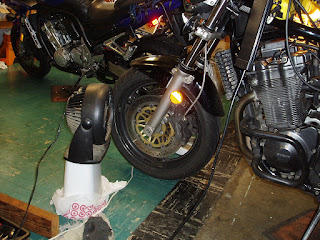After a few weeks of riding through heavy rain the Bandit started idling on 3 cylinders and stalling at stoplights. On acceleration it would fire on all 4 so I suspected either the carb sync I did a few weeks ago was way off, or some dirt got into one of the carbs somehow and plugged the idle circuit. I haven't changed the plugs in 37k miles so that could be an issue as well.
The first thing I did was dump a half can of Seafoam into the tank and top it off with Chevron 91, then ran it about 10 miles. This seemed to smooth it out at speed but the issue soon came back.
The canonical fix for this is to pull the carbs, take them apart, clean everything out with B-12, and reassemble. That is a lot of work. Ultimately that's probably what I'll end up doing, but it means a lost weekend so one looks at easy things first. The easiest thing I could think of was to re-do the carb sync and run a high concentration of fuel system cleaner through it.
Carb sync is not a difficult service but there are some potentially frustrating parts. Allow about 3 hours for the first time.
Specialty tools required: vacuum gauge ("Manometer"). I use a Morgan Carbtune which uses steel instead of mercury vacuum gauges. Also a maintenance gas tank, or long length of fuel hose, to connect the gas tank to the fuel line while adjusting carburetor vacuum. I bought a half gallon Craftsman lawn mower tank on eBay for a couple bucks for this service.
The first step is to remove the gas tank. That is fairly straightforward and I believe I've documented it elsewhere. Important things to note, remove the petcock lever first, and put a rag under the fuel line to catch fuel that comes out of it or the petcock.
Next, cover the alternator with rags to prevent anything from getting into it. Then, using a bent long-jaw needle nose pliers, or similar, remove the tiny rubber caps from the fittings on carbs 1 - 3. They have little wire clamps. I've found it's easiest to just pull the cap and make sure the wire clamp stays attached. They are hard to see and even harder to get at. It's easiest to remove them by pulling them up at an angle toward the right side of the bike.
There is one directly under the choke cable. It can help to unhook the choke cable and/or front throttle cable to get room to remove the cap. The wire clamps are magnetic if one falls into a hard-to-reach place.
The vacuum fitting on carb 4 has a hose instead of a rubber cap. Remove the hose, tape up or otherwise block both ends to prevent vacuum leak. Then hook the Carbtune vacuum hoses to fittings 1 - 4 in order.
Attach maintenance tank to the fuel line and fill with gas. Due to the firing problem I added a half can of Seafoam additive to the half gallon of tune-up gas. Very high concentration of additive.
Before starting the bike it's a good idea to have some fans pointed at the oil cooler. As Bandits are air cooled they will overheat if run for too long without air flow.
Start the bike and watch the Carbtune indicators. Due to the high concentration of additive there was a lot of popping from the exhaust. At 1750 RPM all carbs should be at the same vacuum reading as #4 (far right).
This can be extremely difficult to get exactly right. The adjustment screws are difficult to see, and as the adjustment for one carburetor changes, the rest can also change.
If any carburetors are out of sync turn the adjustment screw to equalize them. In my experience clockwise reduces the vacuum reading (lowers the indicator) whereas counterclockwise raises the indicator. Except sometimes when the opposite seems to happen. In the end the photo above is about as close as I could get them. Carburetor #4 is the index which the rest should sync to.
In practice syncing to 1750 RPM is a guideline at best. The carburetors should be in sync at a variety of RPMs from idle to 2k+. It's a good idea to check them at a range of RPMs and find where they're in sync at the widest RPM range.
After the sync is complete shut off the bike and replace the vacuum caps, pushing them down at an angle from the right side of the bike. Then reattach the tank.
I waited 10 minutes for the fuel additive to settle, then started the bike again. Due to the high concentration of additive there was a lot of smoke from the exhaust after the bike was restarted. I let it idle for 5 minutes or so, then shut it off and re-attached the tank.
After a few days of running a lower concentration of additive in the tank all cylinders are firing. So with some luck I might not need to pull the carbs and clean them out. Will know in a few days.






